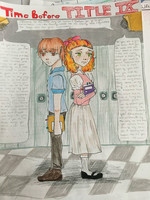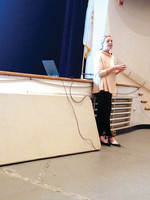By JEN COWART On October 23, students at Park View Middle School welcomed Amanda Walsh, an attorney with the Department of Justice's Office of Violence Against Women for an interactive discussion about Title IX, gender equality and the wage gap. The date
This item is available in full to subscribers.
We have recently launched a new and improved website. To continue reading, you will need to either log into your subscriber account, or purchase a new subscription.
If you are a current print subscriber, you can set up a free website account by clicking here.
Otherwise, click here to view your options for subscribing.
Please log in to continue |
|


On October 23, students at Park View Middle School welcomed Amanda Walsh, an attorney with the Department of Justice’s Office of Violence Against Women for an interactive discussion about Title IX, gender equality and the wage gap. The date coincidentally was just a few days before October 26, which is this year’s date that The Washington Post reported that women essentially start working for free for the final ten weeks of the year, given that the median salary for women working full-time is about 80 percent of men’s, depending on “occupation, working hours, education attainment, experience, and geography.” It was also the same week that the news broke nationwide about a Massachusetts female golfer who was allowed to play on a male golf team, but not allowed to take home the trophy after winning first place.
Walsh’s presentation encouraged student participation, and encouraged students to agree to disagree. She began her discussion by asking the students to share their background knowledge about Title IX. She clarified for them that although the law is often thought of in terms of women and girls, it actually prohibits discrimination on the basis of gender so it protects all genders equally, even though it did tend to impact girls more often. She also clarified that the ruling was not just for sports, but affects all areas, such as STEM fields, stating that all genders must be treated equally and applies to K-12 schools and colleges as well.
When she asked the students where the ideas of gender inequalities come from, they discussed messages that may come from parents, music, television and schools. Walsh showed students her first slide, which was a word art slide filled with words such as power, battle, heroes, weapons, ultimate and enemy. She then switched to a second slide which showed words such as beautiful, style, glitter, accessories, princess hair, fairies and silky. She asked the students to consider the difference between the words on the two slides and told them that the words were chosen from advertising used to describe toys for boys in the first slide and toys for girls in the second slide. The words were taken from advertisements used in recent advertisements and showed the messages that reinforce gender stereotypes.
Walsh then showed the students slides spotlighting some powerful figures in the world, such as members of British Parliament, the G8 Summit Leaders from 2012, top security advisors to President Obama, and top military leaders at the White House. She clicked through the slides once showing all the participants in the photos and then clicked through them a second time with the males removed and the females remaining, spotlighting the fact that so few women have leadership roles in government and society.
“It may not always be 50-50, but these photos show you how drastic the difference is,” said Walsh.
She also shared a photo of the Supreme Court justices and spoke about the drastic shortage of women in the country’s highest court and noted that the current Supreme Court is the closest to equity that the court has ever seen with 109 of the total Supreme Court Justices being men over the years while four have been women, the first woman having been named to the Supreme Court in 1981 by Ronald Reagan.
“Of all the Supreme Court justices, 96.5 percent of them have been men. These are the ideas that are reinforced every day for all of us in many areas,” she said. “We see this again and again, and that’s why it takes a long time for change to be made.”
Walsh spoke about the pay gap between the genders and how it impacts entire families, including their own.
“By 2059 women are expected to reach pay equity if we stay on the same trajectory of change that we have been on since 1960,” she said. “So that would mean that all of you in the audience today would be about 60 years old, and at the tail end of your careers by that time.”
She noted that the pay gap disproportionately affects some families more than others and gave the following examples, using the following family scenarios and a salary of $100,000 as a sample salary: A family with a dad only would make $100,000 in a year. A family consisting of only a mom would only make $80,000 in that same year, given the 20 percent gap. A family consisting of two moms would bring in $160,000 in a year while a family consisting of two dads would bring in $200,000 and a family consisting of a mom and a dad would bring in only $180,000.
Walsh did clarify that some jobs such as teaching jobs do have the same pay for men and women, and do not pay women less than men for doing the same job. She also noted that the wage gap further affects women of color and women of Hispanic descent who make 65 cents and 59 cents on the dollar as compared to white men doing the same job.
When questioned by a student as to why, when Title IX was instituted decades ago, things are moving so slowly, she explained that as with anything, there are steps forward and steps back, depending who is in charge at the time.
“With movements like this, things move forward and things move back, especially during the times of various presidents,” she said. “These messages are perpetuated at home, at school, and in society, but we have to be accountable too. We need to think ‘How am I adding to this, even if I don’t agree with it? How are these stereotypes perpetuated even at Park View, for example?’”
Students cited examples with dress coding girls more often than boys and having different changing areas for girls to change in for physical education classes, while all boys are required to change all together, and the fact that the school’s junior honor society tends to have more girls enrolled than boys.
She encouraged the audience members to be the change in the world that they want to see.
“Think about the things that you might do or say to perpetuate these ideas,” Walsh said. “When you are in school and you see these things, change your own language. Speak to your friends. It’s taken years to change gender equity, and as eighth-graders there will be both men and women in the workplace, in your college classes and out in the world. Change your thought process.
As a follow-up lesson to the presentation, the students were asked to create political cartoons illustrating what they had learned about the topic of Title IX, gender inequality or the pay gap.
Comments
No comments on this item Please log in to comment by clicking here